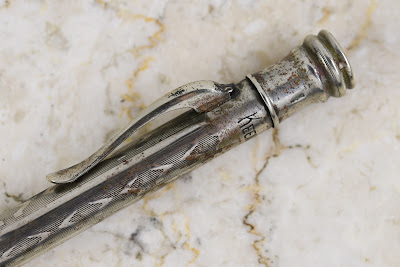This article has been edited and included in The Leadhead's Pencil Blog Volume 6, now on sale at The Legendary Lead Company. I have just a few hard copies left of the first printing, available here, and an ebook version in pdf format is available for download here.
If you don't want the book but you enjoy this article, please consider supporting the Blog project here.
The one Bob sold to me is the silver one at the bottom of the picture. These don’t come along very often – they are the “Keen Point Double Action”:
I’ve got a real affinity for these, because they have these interesting clips that don’t appear anywhere else in the pencil world:
These aren’t Charles Keeran’s “Keen Point” pencils, made in the late 1920s by Dur-O-Lite (and then by others, as detailed in A Century of Autopoint). I explored these pre-Keeran Keen-Points here back in 2013 (the article is now only in the books, at The Leadhead’s Pencil Blog Volume 2, at page 93). The Keen-Point name, as reported in the 1922 edition of Trade-Marks of the Jewelry and Kindred Trades, was held by The O.R. Johnson Co., of Providence, Rhode Island:
At some point since that last article, I stumbled across advertisements confirming that point in The Jewelers’ Circular, in 1921 and 1922:
Joe Nemecek and I talk a lot about our different collecting styles – he’s a “representative sample” collector who, once he has an outstanding example of the breed, is content. I’m an “archival OCD” collector – once I observe two patterns, I’m inclined to try to find the other hundred that might be out laying in the weeds. And if I find two in the same pattern in different materials? Oh, that’s an itch I won’t scratch until I’ve either found or ruled out the possibility that the other patterns came in those materials.
But I have to say, when it comes to the hard-to-find Keen Point Double Actions, I’m finding the range that I’ve turned up to be satisfying . . .
Three different patterns, all done very artfully. . . one each in yellow gold fill, green gold fill and silver(ish).
Thank God two of them weren’t in the same pattern. Or the same material.








No comments:
Post a Comment